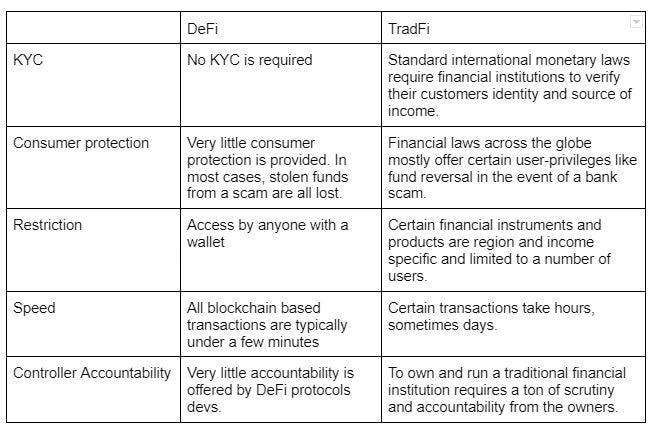Banner Image: Generated by Bitcoin Global Macro
The DeFi space had a tumultuous 2022, with the valuation of leading projects as indicated by the market cap being significantly down for the most part of 2022. Average weekly trading volumes for the DeFi sub-crypto market declined by more than 100% from an all-time high of over $70+ Billion in 2021 to less than 8 Billion by the end of 2022. According to DeFiLama, the Total Value Locked (TVL) across every DeFi protocol had a rollercoaster spin, with the overall TVL dropping from almost $180 Billion in early 2022 to less than $40 Billion in the close of the year.
This decline was due to a number of negative market events, such a hawkish outlook by the US Federal Reserve, the Terra Luna crash and the very recent FTX fiasco.
However, fundamental metrics such as the number of unique DeFi wallet users witnessed some growth. According to on-chain data from Dune analytics, new unique DeFi wallets have floated around a monthly average of 500k. Also, the accumulated DeFi wallet use sits at over 6.6 Million at the close of 2022, up from 4.7 Million in January of 2022. This data reveals a steady growth in usage and traction of DeFi protocols in spite of a slow market.
Top 5 Fundamental Reasons DeFi is Gaining Traction
The entire growth and traction of DeFi has been driven by several factors unique to the technology, which are more advanced than traditional finance infrastructures. Additionally, it is becoming increasingly easy for DeFi innovators to get started by leveraging the expertise of video production services, such as YourFilm, to increase their visibility from the get-go.
Below is a brief breakdown of DeFi’s value proposition in existing capital markets:
Increased accessibility:
DeFi platforms are typically available to anyone with an internet connection, which means that people in underserved or underbanked communities can access financial services that may not have been available to them before.
Lower barriers to entry:
Because DeFi platforms are built on blockchain technology, they can be easily accessed and used by anyone with a smartphone or a computer. This makes it easier for people to participate in the financial system and to access a wider range of financial services.
Greater control:
DeFi platforms are decentralized, which means that they are not controlled by any single entity. This gives users greater control over their own financial affairs and reduces the risk of fraud or manipulation.
Higher returns:
DeFi protocols often offer higher returns on investment compared to traditional financial institutions, which makes them attractive to people looking to earn more on their savings or investments.
Greater transparency:
DeFi platforms are built on transparent and open blockchain technology, which means that all transactions are visible and can be tracked by anyone. This increases transparency and accountability, which can help to build trust in the system.
DeFi – The Future of Cashless Ecosystems
Increasingly, modern societies are becoming cashless and close to all payments are moving to digital means. The implication of societies going cashless in a central financial system has a lot of potential for oppression, especially in corrupt regimes, where the financial laws are tools for political oppression.
However, on the brighter side, the rise of Decentralized Autonomous Organizations (DAOs) is changing the dynamics. By using a DAO to govern a protocol, developers can create a self-governed and decentralized system that is not reliant on a single person or entity for decision-making.
DAOs enhance trust and transparency within DeFi protocols, as well as making the system more resilient to attacks or disruptions. DeepDAO reports that there are currently over 10,000 active DAOs with over 5 million users. This indicates that DAOs are becoming a popular choice for managing decentralized systems, particularly in the DeFi space.

Image source: Bitcoin Global Macro
With traditional financial corporations, it makes more sense to have a governance structure in the hands of the entities with the most skin in the game in terms of equity size which translates to some influence in voting rights. However, with DeFi protocols, the governance voice of stakeholders is dependent on the governance token size for anyone with a wallet and a minimal amount of governance tokens. Also, governance decisions are practically out in the open with votes and improvement proposals being 100% transparent.
This level of automation is much faster than what the traditional corporate governance systems offer; which involves an incredibly low barrier to entry. Therefore displaces the decision-making power away from the hands of a few board members, and simply has the potential of sufficient scrutiny as opposed to a few persons making crucial decisions that affect many. Already some regions like the state of Wyoming are attacking steps to recognize DAOs as legal persons.
In essence, DAOs enhance the efficiency of corporate governance structures in many ways,including:
Decision-making:
In a traditional company, decisions are typically made by a central authority, such as a board of directors or a CEO. In a DAO, decisions are made by the community of stakeholders through a voting process.
Transparency:
Traditional companies are not always transparent about their decision-making processes or the use of their funds. In contrast, DAOs are built on transparent blockchain technology, which means that all transactions and decisions are visible and can be tracked by anyone.
Ownership:
In a traditional company, ownership is typically represented by shares of stock. In a DAO, ownership is represented by tokens, which give holders a say in the decision-making process.
Control:
In a traditional company, a central authority has control over the organization. In a DAO, control is decentralized and distributed among the stakeholders.
Longevity:
DAOs can be terminated if the community of stakeholders votes to do so. In contrast, winding up a traditional company is complicated, especially for publicly traded companies. The process for winding up a public company may be subject to additional regulations and requirements, such as those imposed by securities laws or stock exchange rules. Additionally, the process may be more complex due to the larger number of shareholders and the need to ensure that the interests of all shareholders are fairly represented.
DeFi Vs Traditional Finance
The meteoric growth and adoption we are seeing with DeFi as a financial alternative has been driven by a number of traits contrary to traditional finance conventions. The table below features a brief summary (comparison) of both market ecosystems:

Image source: Bitcoin Global Macro
How DeFi is replacing traditional finance with decentralized systems.
So far the DeFi idea has been driven by a few narratives, mainly disrupting centralized and custodial systems. The question, however, is; how practical and efficient are they? The next section of this article hints at three prominent ones.
Decentralized governance model (DAO):
DAOs have been around as far back as 2016, with the earliest record being with Ethereum’s Slock.it. However, the concept took a whole new wave after it found a new use following the advent of DeFi in 2017, with the rise of use cases like MakerDAO and Uniswap.
As DeFi adoption continues to extend across every financial product and instrument there is, so has DAOs’ application found its way into replacing governance and decision-making protocols on these platforms, and is already the de-facto standard of running all decentralized ecosystems, given its transparency and egalitarian trait. According to DeepDAO, an analytics service, the combined value of all DAO treasuries increased by an estimated 2,400 percent, from $380 million in 2021 to over $8.9 Billions 2022.
Currently, DAOs like Uniswap are exploring more sophisticated governance models that involve greater delegation and siloing of responsibilities. With newer concepts particularly related to the emergence of more recent fundings with legal compliance and asset management, the relevance of DAOs is expected to sweep across the entire financial landscape in no time.
Permissionless financial ecosystems:
One of the leading pros of DeFi technologies is permissionless access to financial products and assets that otherwise require heavy scrutiny to access and are sadly vulnerable to custodial manipulation. Also, a key driver of autonomous smart contracts has been largely due to the possibility to have permissionless transactions on these contracts void of custodial middlemen. Traditional centralized financial systems as we all know are inherently permissioned, requiring financial contracts between individuals to be executed. DeFi as a technology operating outside these limitations has experienced increased growth because of this, finding its ways into industries that are heavily custodial and have high monopoly due to this.
Incentivized Economies:
First, with Bitcoin’s proof of work model and later, peercoins’ proof of stake model, the entire open blockchain economy has been driven by token incentives. The radical idea of having codes reward user behaviors that are beneficial to a decentralized economy and punishing contrary behaviors is continuously proven how inefficient traditional financial models operate.
A leading driver of the entire DeFi ecosystem has been well-planned incentives wired into the operations of these smart contracts. This is also what powers the entire concept of permissionless economies that do not require a custodial controller to run. Token-ncentivized economies is the reason why highly complex DeFi ecosystems operate seamlessly processing millions of transactions effortlessly without any payroll.
The future of DeFi, and the interconnection with TradFi
Evidently, the DeFi ecosystem still has a long way to go before we can talk about toppling the CeFi market share; perhaps we may be seeing these two worlds merge into a more futuristic financial ecosystem. Already, traditional financial powerhouses like JP Morgan are exploring the possibilities available to conventional DeFi platforms, to launch its first DeFi-powered cross-border payment solution.
However, a drawback to this is the regulatory uncertainty that was not originally designed for this level of innovation. Currently, the DeFi industry is facing strict regulatory scrutiny in many jurisdictions. This threatens the fundamental principles of the DeFi ecosystem, which is based on anonymity, decentralization, and a permissionless financial economy. In order for DeFi to reach its full potential, regulatory concerns such as money laundering, tax evasion, financing terrorism, fraud, and systemic risks must be properly addressed.
While DeFi may not fully replace traditional finance (TradFi), there may be an intersection between the two where DeFi protocols can access off-chain data through a reliable centralized third-party platform.



